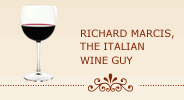Ripasso Wines - For Those Who Love Big Reds But Can’t alwAYS Afford Amarone
Ripasso is a red wine from the Valpolicella zone located north of Verona in the Veneto region of Italy. Ripasso is generally less well known than Valpolicella and Amarone wines, also from this area, even though it shares some features of both wines.
The term “Ripasso” sounds like and in fact means “repassed.” That refers to its production process whereby regular, fermented Valpolicella (which is a blend of three regional native red grape varieties - Corvina, Rondinella and occasionally Molinara) is added to a cask containing the skins and lees left over from recently fermented Amarone wines. The process of adding (or "repassing”) the lighter Valpolicella wine over the remainders of the “bigger” Amarone wine imparts additional color, texture and flavor to the Valpolicella wine. Also, it induces a second fermentation of the wine that increases the wine’s alcoholic content.
The end result is a wine called Ripasso that retains the vibrancy of Valpolicella but is darker in color, bigger and more flavorful and complex than the original Valpolicella. It’s a wine with sufficient stuffing to go with hearty foods such as stews, braised red meats, game and aged cheeses. In 2009, Ripasso della Valpolicella received its own DOC designation.
Ripasso wines are sometimes casually referred to as “baby Amarones.” The same combination of grape varieties from the Valpolicella zone used to produce Ripasso are also used to produce Amarone. The two wines also share some of the same aroma and flavor profiles.
The two wines are also made with similar but not identical processes, Amarone (known more formally as Amarone della Valpolicella) wines are made with partially dried grapes in a process known as appassimento and then aged in large wooden casks for at least 2 years prior to release. The use of partially dried grapes and the longer ageing process results in wines that are more alcoholic (usually 15 to 16 percent alcohol by volume), full bodied and flavorful than Ripasso-style wines. The rich aroma and flavor notes of Amarones are often compared to those of Port wines. Like Port, they are also long-lived wines and can take many years to reach optimal maturity.
Due to their more intensive production process and longer ageing requirements, Amarone wines are considerably more expensive than Ripasso wines. Whereas Ripasso wines generally retail in the $15 to $25 price range, prices of Amarone wines typically run from $50 on up with some Amarones from premier producers sporting triple-digit price tags.
Because they are expensive, most real folks - folks like you and me - store their Amarones in basements or wine cellars, reserving them for special occasions.
Ripasso-style wines offer a convenient and affordable alternative to Amarone wines. Ripasso wines are rich, full-bodied and share some of the same aroma and flavor profiles as Amarone wines, just less so. Since Ripasso wines are more approachable and less expensive than Amarones they can be enjoyed regularly while saving the Amarones for special occasions when a more awe-inspiring wine is in order.
Ripasso wines can be served with a number dishes such as risotto and hearty pasta dishes. But they are at their best when paired with hearty dishes like roasted veal or lamb or braised or barbequed red meats like steak, sausage and game. Ripasso also goes well with aged cheeses like Parmigiano-Reggiano. My recommendation - try it with a porcini mushroom risotto or braised veal shank with herbs.
Below are some Ripasso-style wines that are generally available in most well-stocked wine shops. The wines are listed alphabetically by producer.
Fine value-priced Ripasso wines worth looking for:
Begali, “La Cengia” Ripasso Valpolicella Classico Superiore 2010 (about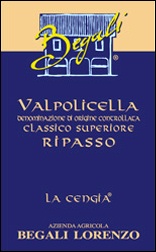 $18)
$18)
This is a deep, rich Ripasso with black cherry aromas and flavors intertwined with espresso, kitchen spice and cassis notes. There is good acidity, smooth texture, and just a hint of tannin on an elegant finish.
Cesari, “Mara” Valpolicella Ripasso Superiore 2009 (about $18)
Although the Cesari winery established its reputation through its 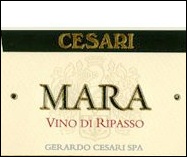 outstanding Cesari Amarone, the winery also produces a number of other high-quality wines such as this Ripasso. This warm and elegant single-vineyard (Mara) Ripasso with its seductive dark-fruit flavors goes a long way to explaining why Ripasso-style wines have become increasingly popular in recent years.
outstanding Cesari Amarone, the winery also produces a number of other high-quality wines such as this Ripasso. This warm and elegant single-vineyard (Mara) Ripasso with its seductive dark-fruit flavors goes a long way to explaining why Ripasso-style wines have become increasingly popular in recent years.
Farina 'Remo Farina' Valpolicella Classico Superiore Ripasso 2009 (about $18)
Founded in the early 1800’s, the family-run Farina winery is now in the 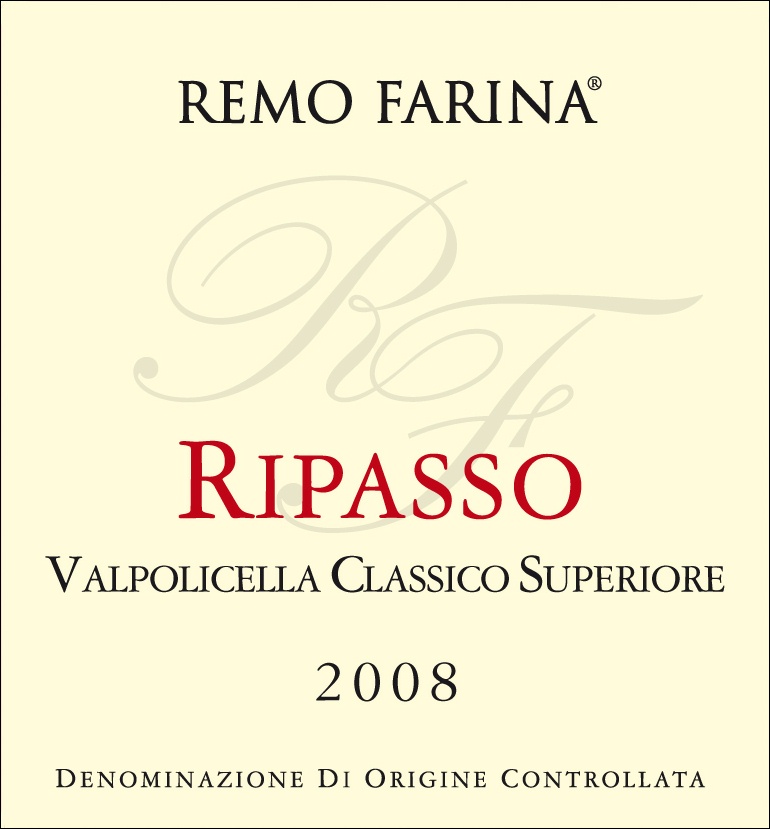 capable hands of two cousins, Alessandro and Pietro. They produce a small number of traditional red and white wines from the Valpolicella zone including this lovely, full-bodied Ripasso wine with rich flavors of dried fruit and light oak and vanilla notes. This traditional Ripasso-style Valpolicella is aged in large old oak casks for 6 months. It has loads of flavor and is a terrific value.
capable hands of two cousins, Alessandro and Pietro. They produce a small number of traditional red and white wines from the Valpolicella zone including this lovely, full-bodied Ripasso wine with rich flavors of dried fruit and light oak and vanilla notes. This traditional Ripasso-style Valpolicella is aged in large old oak casks for 6 months. It has loads of flavor and is a terrific value.
Masi, Campofiorin Rosso del Veronese 2008 (about $16)
Since this wine is made by a special “double fermentation” process patented by Masi, the Masi Campofiorin does not fit neatly into the 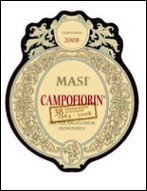 traditional Ripasso format. Nonetheless, it exhibits the traditional Ripasso character and flavor profile.
traditional Ripasso format. Nonetheless, it exhibits the traditional Ripasso character and flavor profile.
The Masi Campofiorin is aged in wood for 18 months and then spends 3 additional months in the bottle prior to release for sale. This wine has a deep bright red color with a purple edge. The Campofiorin is rich, ample and complex with juicy fruit and soft tannins. It pairs well with hearty stews and braised meat dishes.
Montresor, “Capitel della Crosara” Valpolicella Ripasso 2009 (about $18)
The Montresor family has been making wine since the 1600’s and today owns around 375 acres of prime vineyards in the Veneto region. They combine traditional, time -tested methods with modern winemaking concepts and technology to produce rich, elegant wines. Montresor’s “Capitel della Crosara” Valpolicella Ripasso is a cru (single vineyard) wine produced from grapes grown on the estate’s “Capitel della Crosara” vineyard. The Ripasso is aged in oak for 16 months and has intense dark cherry, vanilla and sweet spice flavors.
Pietro Zardini, “Austero” Valpolicella Ripasso Superiore 2008 (about $18)
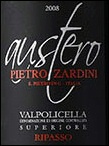 The Zardini winery traces its origins in the Veneto back to the mid-1800’s. They’ve had a long time to practice their craft and it shows in this interesting and aromatic Ripasso that is dense with flavors. It is a full-bodied without being heavy and juicy with dark-fruit flavors, modest tannins and respectable acidity.
The Zardini winery traces its origins in the Veneto back to the mid-1800’s. They’ve had a long time to practice their craft and it shows in this interesting and aromatic Ripasso that is dense with flavors. It is a full-bodied without being heavy and juicy with dark-fruit flavors, modest tannins and respectable acidity.
Secco-Bertani, Valpolicella Valpantena Ripasso 2009 (about $19)
The Bertani winery has been in continuous operation since 1857 and is generally credited with being the chief architect of today’s ripas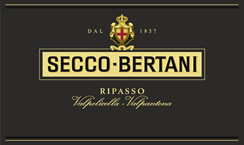 so-style Veronese wines. In the 1870’s the Bertani winery created a “dry” (or secco) version as an alternative to the then-prevailing sweet ripasso wines of Valpolicella, hence Secco-Bertani.
so-style Veronese wines. In the 1870’s the Bertani winery created a “dry” (or secco) version as an alternative to the then-prevailing sweet ripasso wines of Valpolicella, hence Secco-Bertani.
The Valpantena is a sub-zone of Valpolicella.
The 2009 Secco-Bertani Ripasso Valpolicella Valpantena opens with a broad and elegant bouquet of cinnamon and dried fruit. It is a delicious wine that features flavors of dried cherries, black berries and kitchen spices and ends with a pleasantly bitter almond note on the finish.
Tenuta Sant'Antonio, “Monti Garbi” Valpolicella Superiore Ripasso 2009 (about $18)
In the late 1980’s, four brothers - Armando, Paolo, Tiziano and Massimo Castagnedi - decided to produce their own wine on their family’s Sant’Antonio estate in the Valpolicella area. In 1989 they purchased 75 acres of land around Mezzane, which, when added to the estate’s existing property expanded the Tenuta Sant’Antonio vineyards to a total of 125 acres. They also built a new winery and in 1995 produced their first wine, an Amarone. Within its short history the winery has garnered considerable recognition and awards from in-the-know wine drinkers and wine rating organizations.
Tenuta Sant’Antonio’s ’09 Monti Garbi Ripasso is a real winner. The wine is sourced from grapes grown on the estate’s Monti Garbi vineyard and is aged for 16 months in a combination of new and used large oak casks. It has a touch of sweetness on an otherwise full-bodied frame with firm tannins and congenial acidity that keep the flavors juicy. It is balanced and composed with notes of sweet kitchen spices on the finish.
Slightly more expensive Ripasso wines that are well worth the price:
Albino Armani, Valpolicella Ripasso Classico Superiore DOC 2009 (about $25)
Albino Armani is a celebrated Veneto winery that has a long winemaking lineage that dates back to 1607 and this date is prominently displayed on their wine labels.
The grapes for Albino Armani’s Ripasso are sourced from old vines in the high hills of Marano in Valpolicella, about 1,400 feet above sea level. Their 2009 Ripasso has ripe black berry and cherry fruit flavors supported by refreshing acidity and a persistent and warm finish. More recent bottlings are now available on wine shop shelves including, as of this posting, the 2012 and 2013 vintages. Regardless of vintage they all represent good value on a quality-to-price basis.
Bussola, “Ca' del Laito” Valpolicella Superiore Ripasso 2006 (about $22)
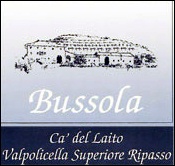 This wine is from one of the premier producers in Valpolicella zone. Made in a forward and bold style, this lovely Ripasso struts its stuff with big, ripe cherry jam and black currant flavors followed by a rich, smooth finish. Sweet tannins and an undertow of acidity tie it all together nicely.
This wine is from one of the premier producers in Valpolicella zone. Made in a forward and bold style, this lovely Ripasso struts its stuff with big, ripe cherry jam and black currant flavors followed by a rich, smooth finish. Sweet tannins and an undertow of acidity tie it all together nicely.
Corte Sant’Alda, “Campi Magri” Valpolicella Ripasso 2008 (about $40)
In 1985 Marinella Camerani made the decision to uproot herself from her comfortable life in Verona and pursue her dream of living in the country and reviving what had been her family’s country estate above the village of Mezzane de Sotto. Without any real winemaking background, she started growing grapes and producing her own wines using organic farming and sustainable winemaking principles. And, as it turns out, she made some very good wines. So good that in 2008 she received the prestigious “Grower of the Year” award from Gambero Rosso, Italy’s most authoritative guide to the Italian wine world.
Corte Sant’Alda's 2008 Campi Magri Ripasso is a fine grained and less concentrated than other Ripasso-style wines. The emphasis is on subtlety and elegance and letting the flavors of the traditional grape varieties assume center stage. Enticing aromas of dark cherries and dried herbs segue into dark fruit flavors followed by a rich and smooth finish.
Giuseppe Lonardi, Ripasso Valpolicella Classico Superiore 2011 (about $23)
The Lonardi estate consists of 18 acres of prime vineyards from which they produce traditional red wines of the Valpolicella area. The Lonardi Ripasso wine is aged for 12 months in second-passage French Oak barriques and then undergoes a further 6 months ageing in the bottle before release for sale. Rich and juicy, this Ripasso has plenty of tannic grip and an engaging, slightly bitter note on a fine finish.
Masi, Brolo di Campofiorin Oro 2011 (about $26)
While technically not a Ripasso, Masi’s Brolo di Campofiorin shares some of the same production techniques and flavor profile as Ripasso wines. Comprised of Corvina, Rondinella and a splash of Oseleta, the Brolo di Campofiorin is the cru version of the estate’s Campofiorin wine. And like the basic Campofiorin, the wine is produced using Masi's double-fermentation system where wine from fermented grapes is refermented with 30 percent, semi-dried Corvina grapes. It is then aged for 24 months in small oak casks to heighten the flavors and complexity of the wine. The end product is rich with mouth-coating, velvety dark-fruit flavors that are both complex and elegant. It is a fine companion for robust meat dishes.
Speri, Valpolicella Classico Superiore DOC Ripasso 2009 (about $24)
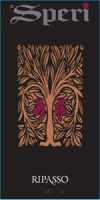 Founded in the late 1800’s, the Speri winery has grown over time and today has 125 acres under vine, all of which are in the prized Valpolicella Classico zone. The Speri winery produces a small number of traditional wines from the Valpolicella area including this lovely, elegant '09 Ripasso. It has complex and intense dark-fruit aromas with spice notes. It is full-bodied with a racy acidity that is well integrated with the sweet tannins.
Founded in the late 1800’s, the Speri winery has grown over time and today has 125 acres under vine, all of which are in the prized Valpolicella Classico zone. The Speri winery produces a small number of traditional wines from the Valpolicella area including this lovely, elegant '09 Ripasso. It has complex and intense dark-fruit aromas with spice notes. It is full-bodied with a racy acidity that is well integrated with the sweet tannins.
Tommasi, Ripasso Valpolicella 2009 (about $25)
Starting with a tiny vineyard acquired in 1902 in the heart of the Valpolicella Classico region, the Tommasi estate has grown 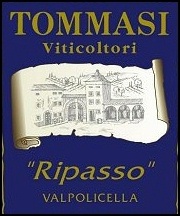 steadily over time and currently extends over 338 acres. Today the estate is run by the 4th generation of the Tommasi family, 9 family members working in tandem but each with their own defined areas of responsibility. Based on the results, what could be a complicated family arrangement seems to work very well.
steadily over time and currently extends over 338 acres. Today the estate is run by the 4th generation of the Tommasi family, 9 family members working in tandem but each with their own defined areas of responsibility. Based on the results, what could be a complicated family arrangement seems to work very well.
The ’09 Ripasso from Tommasi is ripe, rich and robust, offering powerful blackberry and currant flavors wrapped in soft, gentle tannins with a pleasant touch of bitter almonds on the finish.
Zenato, Valpolicella Superiore Ripassa 2011 (about $26)
Founded in 1960 by Sergio and Carla Zenato, the winery is now run by their son, Alberto, who is in charge of all aspects of production, and daughter, Nadia, who handles marketing and distribution. The winery has within in its relatively short history developed a well-deserved reputation for producing exceptional wines at affordable prices. Their wines are widely distributed throughout Italy and the world.
Like previous versions, Zenato’s 2011 Ripassa (Zenato is the only 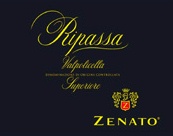 producer to call its Ripasso a “Ripassa”) is an absolutely delicious wine and a great value at this price. The wine is aged in a combination of small and large oak casks for 18 months followed by 6 months in the bottle prior to release for sale. It is a full-bodied wine with full-on flavors of blackberries and dried fruit such as raisins and black currants accented with sweet kitchen spice notes. Smooth and well-balanced with a velvety texture, good acidity, gentle tannins and a long finish will keep you coming back for more.
producer to call its Ripasso a “Ripassa”) is an absolutely delicious wine and a great value at this price. The wine is aged in a combination of small and large oak casks for 18 months followed by 6 months in the bottle prior to release for sale. It is a full-bodied wine with full-on flavors of blackberries and dried fruit such as raisins and black currants accented with sweet kitchen spice notes. Smooth and well-balanced with a velvety texture, good acidity, gentle tannins and a long finish will keep you coming back for more.
©Richard Marcis
Updated October 26, 2016
Return to italian wine reviews
Help keep this website ad-free and independent.
Consider making a contribution to support the work of WineWordsWisdom.com.

